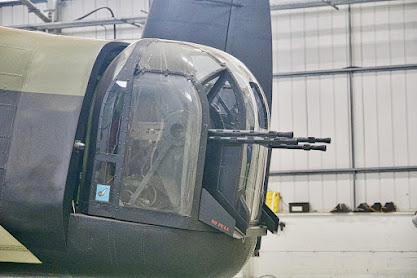The B-28 Fortress was a heavy bomber aircraft that was developed by the United States during World War II. It was one of the most iconic planes of the time, and played a crucial role in helping the Allies win the war.
The B-28 was capable of carrying a massive load of bombs and had a very long range, which made it very effective in both strategic bombing missions over Europe and in the Pacific theater. However, the B-28 was eventually retired from service after the war in favour of newer bombers such as the B-36.

INTERIOR OF A B-17 FLYING FORTRESS
BALL TURRET
The ball turret was a type of gun turret that was mounted in the belly of certain World War II-era bomber aircraft, such as the B-17 Flying Fortress and the B-24 Liberator. It was essentially a spherical structure that contained one or two .50 caliber machine guns, which were operated by a gunner who was situated inside the turret. The ball turret allowed for greater firepower and protection from enemy fighter planes, as it provided a full 360-degree field of fire, and its location in the lowest part of the plane made it a difficult target to hit. However, the position of the gunner in the cramped, unheated ball turret made it one of the most dangerous jobs in the bomber crew, as it left them exposed to damage from enemy fire and subjected them to extreme cold temperatures at high altitudes.
TAIL TURRET
A tail turret is a defensive structure used on some military aircraft to protect against attacks from behind. It is typically located at the tail end of an aircraft and includes a mounted weapon, such as a machine gun or cannon, and a gunner's seat. The gunner can rotate the turret and fire in any direction to engage incoming enemy aircraft. Tail turrets were commonly used during World War II and have since been replaced by more advanced defensive systems.
B-29 SUPERFORTRESS dropped atomic bombs LITTLE BOY and FATMAN in HIROSHIMA and NAGASAKI in 1945 and these leads to the break down of one of the AXIS FORCE IMPERIAL JAPAN.✌✌✌✌










No comments:
Post a Comment